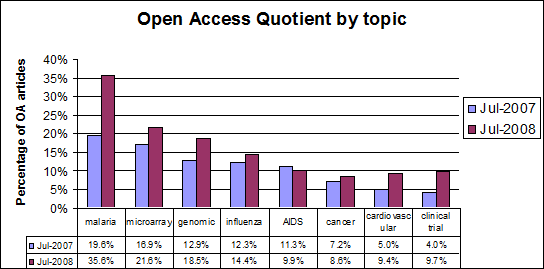Just over a year ago, this blog post introduced the concept of the Open Access Quotient, an easy-to-calculate metric for the fraction of the biomedical literature that is immediately freely accessible in full text form, for a given subject area.
Now seems as good a time as any to revisit this metric, to get a sense of what progress has been made in opening up the literature. Has the growth of open access publishing, and the strengthening of the NIH open access policy, had a measurable impact on the accessibility of research?
Looking at the biomedical literature has a whole, there has clearly been progress. The fraction of recent PubMed abstracts that will link the users straight through to the fulltext, with no permission barrier getting in the way, is up from 6.8% to 8.56%. There’s still a long way to go, but that’s a lot more immediate open access articles (about 1000 more per month, in fact).

Looking at particular topic areas, the results just as encouraging:

It is clear that open access is close to becoming the norm rather than the exception for publications in areas such as malaria and genomics, and the take-up of open access in these areas seems to still be growing fast, rather than showing any signs of plateauing. Just as encouraging is the doubling in the proportion of clinical trials publications that are now open access.
We will be sure to keep a close eye on how the OAQ for these fields, and PubMed as a whole, develops over the next 12 months.
[One caveat on the use of OAQ figures. While BioMed Central sends newly published articles to PubMed on a nightly basis , some publishers send data in large batches. Probably for this reason, OAQ figures can vary a fair amount from day to day. Multiple measurements should be done over the course of a month for maximum reliability. ]
As a professional practicing in the developing part of the world, I strongly support the increased availability of literatures on the ‘Open Access’ basis. It is encouraging to hear that there is significant increased availability of literatures on malaria but a pity to learn that the reverse is happening on literatures dealing with AIDS. Both diseases are mainly problems of the developing world. We should not also forget the noble initiatives like HINNARI (a WHO project) which avail journals for selected institutions in the developing world. But still there is a long way to go…